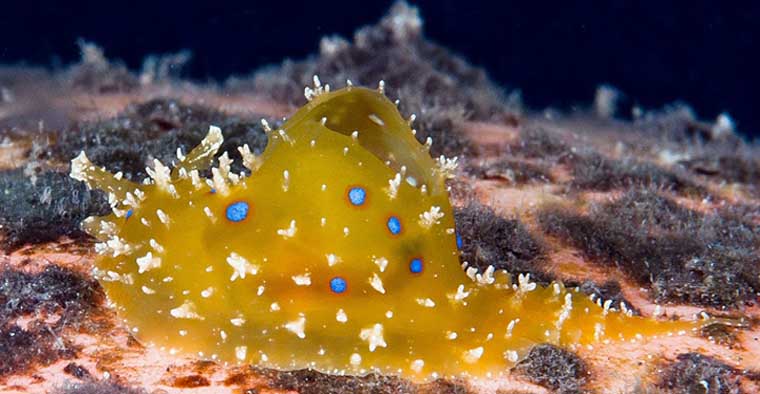This species has been observed on Reunion, Mauritius and Mayotte Islands
Species characteristics : The body ranges in colour from bright yellow to bright green with few to many scattered ocellate spots. The spots are usually blue to pink, often with a reddish edge There usually a scattered short branching papillae over the body |

|
|
| Showing species characteristics... | Photo Bernard Deuss |
|
Remarks :
Identification confirmed by Nathalie Yonow
Synonymous : (according Worms)
- Aplysia longicauda Quoy & Gaimard, 1825
- Notarchus stimpsoni Baba, 1937
Bibliographic data :
The coloration of the spot seems to be variable :
- spots are usually blue to pink, often with a reddish edge.
- in some specimen, surrounding the spot is a clear ring then a ring of orange.
- in some specimens the red edge dominates and the blue spots appear red.
- white and blue spots without a surrounding ring can also occur...
The body is very elongate and its most characteristic feature is the extremely prolonged narrow tail which can make up to half the body's total length.
The rolled oracle tentacle and rhinophores are very long, uniformly coloured with the body
The sole produces a very sticky mucus
Animals in the red sea are soft and smooth.
The spawn consists of an irregular tangle yellow or brown, spaghetti-like strands laid directly onto the floating algae.
It is a planktonic species. Found on the floating algae such as Sargassum where it is presumably feeding on epiphytic cyanobacteria or on drifting debris (although it may also be found occasionally on mooring lines or buoys).
Stylocheilus citrina is a synonym.
The yellowish body color with large blue spots and no lines distinguishes this species from S. striatus
References :
Bill Rudman Seaslug site : Sea Slug Forum : Stylocheilus longicauda
Nudipixel Stylocheilus longicauda
Publications :
Martínez E. & Ortea J. (1990). Moluscos opistobranquios de Cabo Verde: Anaspidea (Aplysiomorpha). Publicações Ocasionais da Sociedade Portuguesa de Malacologia. 15: 17-42
Quoy, J.R.C. & Gaimard, J.P. 1824. Zoologie. In : L. de Freycinet, (ed.). Voyage autour du monde exécuté sur les corvettes de S.M. l'Uranie et la Physicienne pendant les années 1817, 1818, 1819, et 1820 . Paris. [Nudibranchia, pp 417-420, pl. 66, figs, 4,13 ; pl.87, figs 7-10]
Other photos of Stylocheilus longicauda :
Cédric Péneau Réunion, mouillage du petit tombant d'etang salé, 3 m, 10 February 2013, size : 30-40 mm |
 |
 |
Christophe Cadet Réunion, Bassin pirogue at Etang Salé, less 1 m, 14 february 2014, size : 20-25 mm
About 20 spécimens on the same area...
|
Yann von-Arnim Mauritius, Mahebourg Marine Farm, 6 m, 14 April 2015, size : 40 mm
On the breeding nets of the marine farm, I saw a gregarious behavior of Stylocheilus longicauda. There were 3 to 6 individuals individus/m2. With its probably spawn ... .jpg) |
.jpg) |
More photos from Indian Ocean
Reunion, Stylocheilus longicauda, at Saint Leu, by Geoffrey Bertand